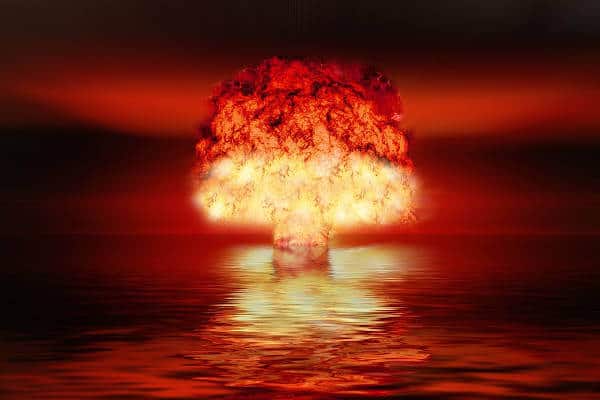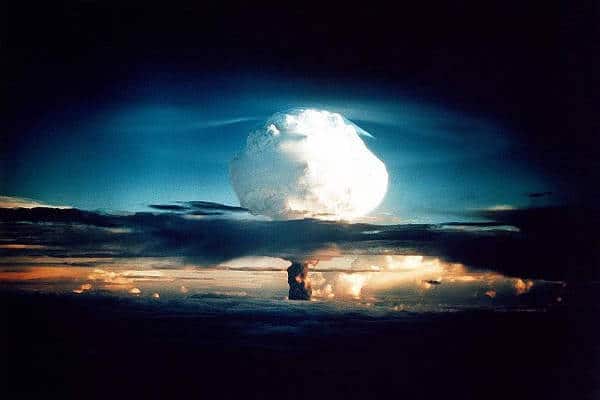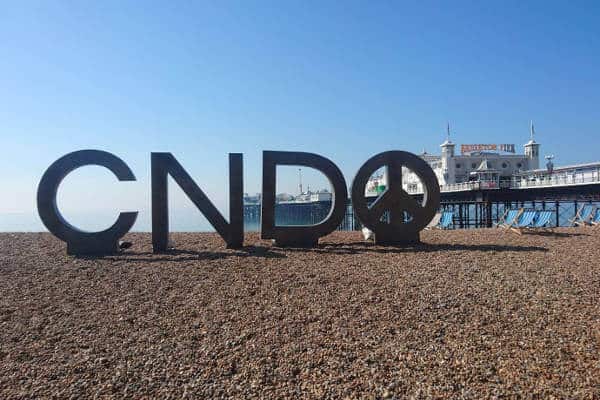Nuclear bombs are weapons of mass destruction. They harness the forces that hold the nucleus of an atom together by using the energy released when the particles of the nucleus (neutrons and protons) are either split or merged.
The effects of nuclear weapons would be catastrophic. to all life. That’s why CND campaigns against them. Click here to find out more about our campaigns.
Types of Nuclear Energy
There are two ways that nuclear energy can be released from an atom:
- Nuclear fission – the nucleus of an atom is split into two smaller fragments by a neutron. This method usually involves isotopes of uranium (uranium-235, uranium-233) or plutonium (plutonium-239).
- Nuclear fusion – two smaller atoms are brought together, usually hydrogen or hydrogen isotopes (deuterium, tritium), to form a larger one (helium isotopes); this is how the sun produces energy.
The Atomic Bomb

Nuclear fission produces the atomic bomb, a weapon of mass destruction that uses power released by the splitting of atomic nuclei.
When a single free neutron strikes the nucleus of an atom of radioactive material like uranium or plutonium, it knocks two or three more neutrons free. Energy is released when those neutrons split off from the nucleus, and the newly released neutrons strike other uranium or plutonium nuclei, splitting them in the same way, releasing more energy and more neutrons. This chain reaction spreads almost instantaneously.
Atomic bombs were exploded in war in Hiroshima and Nagasaki at the end of World War II.

The Hiroshima Bomb
Due to its long, thin shape, the Hiroshima bomb was called ‘Little Boy’. The material used was uranium 235. It is believed that the fission of slightly less than one kilogram of uranium 235 released energy equivalent to approximately 15,000 tons of TNT.
The Nagasaki Bomb
Compared to the one used on Hiroshima, the Nagasaki bomb was rounder and fatter. It was called ‘Fat Man’. The material used was plutonium 239. The fission of slightly more than one kilogram of plutonium 239 is thought to have released destructive energy equivalent to about 21,000 tons of TNT.
The Hydrogen Bomb

Nuclear fusion is a reaction that releases atomic energy by the union of light nuclei at high temperatures to form heavier atoms. Hydrogen bombs, which use nuclear fusion, have higher destructive power and greater efficiencies than atomic bombs.
Due to the high temperatures required to initiate a nuclear fusion reaction, the process is often referred to as a thermonuclear explosion. This is typically done with the isotopes of hydrogen (deuterium and tritium) which fuse together to form Helium atoms. This led to the term ‘hydrogen bomb’ to describe the deuterium-tritium fusion bomb.
The first hydrogen bomb was exploded on 1st November, 1952 at the small island of Eniwetok in the Marshall Islands. Its destructive power was several megatons of TNT. The blast produced a light brighter than a thousand suns and a heatwave felt 50 kilometres away. The Soviet Union detonated a hydrogen bomb in the megaton range in August 1953. The US exploded a 15 megaton hydrogen bomb on 1st March, 1954. It had a fireball of 4.8 km in diameter and created a huge mushroom-shaped cloud.
The Effects of a Nuclear Weapon
If one of these bombs were ever used, the effect would be catastrophic.

The heart of a nuclear explosion reaches a temperature of several million degrees centigrade. Over a wide area the resulting heat flash literally vaporises all human tissue. People inside buildings or otherwise shielded will be indirectly killed by the blast and heat effects as buildings collapse and all inflammable materials burst into flames. Those in underground shelters who survive the initial heat flash will die as all the oxygen is sucked out of the atmosphere.
Outside the area of total destruction there will be a gradually increasing percentage of immediate survivors. However most of these will suffer from fatal burns, will be blinded, bleeding and suffering massive internal injuries. Survivors will be affected within a matter of days by radioactive fall-out. Radiation-induced cancers will affect many, often over twenty years later.
Nuclear weapons cause severe damage to the climate and environment on a scale incomparable to any other weapon: the Red Cross estimates that a billion people around the world could face starvation as a result of nuclear war.
Campaign against nuclear weapons

Taking into account the effects a nuclear bomb would have, it is no surprise that CND campaigns against nuclear weapons. They are immoral and expensive weapons of mass destruction, which have no military or strategic function in the face of 21st century threats.
Join us as we campaign against Trident, Britain’s nuclear weapons and for the ultimate goal of a nuclear weapons-free world.

